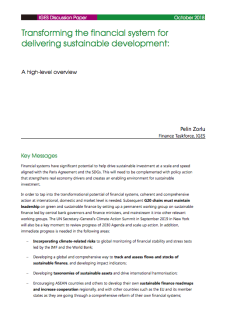
This paper makes high-level recommendations for harnessing financial systems to drive sustainable investment at a scale and speed aligned with the Paris Agreement and the UN Sustainable Development Goals (SDGs). TIt argues that in order to tap into the transformational potential of financial systems, coherent and comprehensive action at international, domestic and market level is needed. Subsequent G20 chairs must maintain leadership on green and sustainable finance by setting up a permanent working group on sustainable finance led by central bank governors and finance ministers, and mainstream it into other relevant working groups. The UN Secretary-General’s Climate Action Summit in September 2019 in New York will also be a key moment to review progress of 2030 Agenda and scale up action. In addition, immediate progress is needed in the following areas:
- Incorporating climate-related risks to global monitoring of financial stability and stress tests led by the IMF and the World Bank;
- Developing a global and comprehensive way to track and assess flows and stocks of sustainable finance, and developing impact indicators;
- Developing taxonomies of sustainable assets and drive international harmonisation;
- Encouraging Association of Southeast Asian Nations (ASEAN) countries and others to develop their own sustainable finance roadmaps and increase cooperation regionally, and with other countries such as the EU and its member states as they are going through a comprehensive reform of their own financial systems;
There is no silver bullet to financing a global energy transformation, alongside tackling other major socio-economic and environmental objectives. However, national governments (and sub-national governments where appropriate) will need to do the heavy lifting when it comes to creating the right enabling environment and coming up with the most appropriate policy and fiscal levers. Areas where governments can take short to medium-term action include:
- Providing long-term policy signals to investors, financiers and businesses to overcome short-termism, for instance in the shape of national sustainable infrastructure and capital raising plans;
- Using public finance levers more effectively (including blending) to crowd in private investment and de-risk projects both domestically and through Multilateral Development Banks and Development Finance Institutions;
- Targeted financial regulatory interventions – including enhancing good quality disclosure of Environmental and Social Governance (ESG) and climate related risks; updating fiduciary duty definitions; revising supervisory bodies’ mandates accordingly; strengthening corporate governance reforms ensuring they are retooled to reflect new risks and opportunities.
